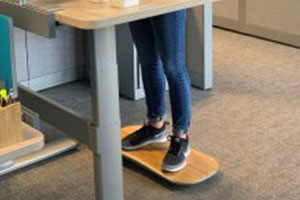To Balance Board or Not to Balance Board?
Posted on September 4, 2019 | in Ergonomics

There are plenty of office products on the market that advertise as being “ergonomic” and claim to provide a variety of health benefits. Sometimes it can be difficult to tell which products will pay off and which will be used once and never touched again.
Balance boards have traditionally been used in the rehabilitation and physical therapy field but have been making their way into office environments over the past few years as an accessory to use with sit-stand desks. They have a flat standing surface with a curved bottom and allow users to shift their weight and stand while maintaining balance. But, do these boards get the ergonomists’ seal of approval?
Here’s what you need to know about using a balance board versus sitting or standing at your desk based on research from a 2018 study by Nelson, Casanova, and Vella:
- There was no significant difference in productivity between sitting, standing, or balance board conditions.
- There was no significant difference in pain or fatigue levels between sitting, standing, or balance board conditions.
- Using the balance board led to energy expenditure that is higher than normal standing and is significantly higher than sitting.
While the balance board provides a statistically significant difference in caloric expenditure, the difference only projects to about 25 kilocalories a day and provides little physiological benefit. Overall, the balance board is an alternative to prolonged sitting or standing at work but should not replace time spent in active movement.
If you’d like to see a VelocityEHS ergonomist’s review of The Level balance board by FluidStance, check out our product review.
Nelson, M. C., Casanova, M. P., & Vella, C. A. (2018). The Effectiveness of Standing on a Balance Board for Increasing Energy Expenditure. Medicine and science in sports and exercise.